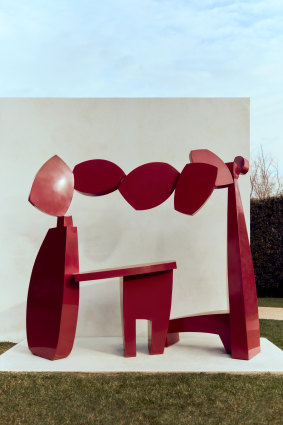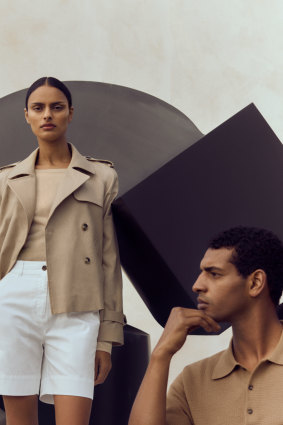Sponsored by Trenery
By Michelle Bateman
“The Italian novelist, Umberto Eco, used to say that books talk to one another. Well, I think sculptures in the park talk to one another,” says the curator Geoffrey Edwards about the Sculpture Park at Pt. Leo Estate on Victoria’s Mornington Peninsula. Edwards is no mere observer to this conversation: the esteemed curator and former director of Geelong Gallery has been an advisor to Pt. Leo Estate since 2016, curating a collection of 60 mostly large-scale sculptures from the likes of Yayoi Kusama, Ugo Rondinone and Reko Rennie.

Philip Spelman, Parabola (2008), painted steel Credit: Trenery
Four sculptures by Australian
and international artists – Clement
Meadmore’s Riff (1996), Michael Le
Grand’s Tsunami (1997), Bert Flugelman’s
Conversation (2007) and Parabola (2008)
by Philip Spelman – form a dramatic
backdrop to the spring 2024 campaign
from Trenery.
In the campaign images, the timeless Australian brand becomes a fashionable participant in the sculptures’ tête-à-tête. The abstract volumes of Parabola are mirrored in the fullness of a sleeve; the surprising agility of Meadmore’s Riff lends a lyrical quality to a palette of neutrals and sandy tones.
The campaign is the latest move by Trenery to explore new synergies with artists working across different mediums. It began last year with a new brandmark, designed by renowned typographer Andrew Woodhead, who drew inspiration from the Gothic script seen on the streets of Paris and the gentle rolling hills behind his home in Victoria’s Macedon Ranges.
Sculptures and charcoal drawings by Sydney artist Camie Lyons are on permanent display at selected Trenery stores and the ceramicist Jan Vogelpoel was commissioned to create a suite of custom sculptures for Trenery’s Brighton concept store.
An enduring muse
Art history has long been fruitful territory for fashion design, from Yves Saint Laurent’s 1965 Mondrian collection – in which cocktail dresses were adorned with the sharp geometrics of the Dutch artist – to Versace’s 1991 homage to Andy Warhol, complete with the Pop artist’s portraits of Marilyn Monroe and James Dean printed and beaded onto figure-hugging gowns.
Today’s crop of fashion designers, however, takes a different approach, says Diane Curtis, a fashion lecturer at RMIT University and Collarts in Melbourne. “I see art influencing this generation of designers through [their desire to create] clothing as a form of abstract expression rather than for functionality.” She points to the Paris-based fashion company Maison Margiela and the Japanese brand Comme des Garçons as challenging the very notion of what fashion can be. “John Galliano, the current creative director of Margiela, demonstrates an avante-garde and theatrical approach, which demonstrates fashion as a real form of art.”
Partners in style
It’s not unusual for fashion designers today to welcome artists into their studio and build an ongoing relationship. Raf Simons, the former creative director at Dior, has collaborated with the American artist Sterling Ruby for many years. “The garments look like canvases, showcasing Ruby’s paint splatters and intricate designs,” says Curtis.

Trenery’s latest campaign imagery, curated by advisor Geoffrey EdwardsCredit: Trenery
The buzz from a well-timed collaboration can benefit designer and artist alike, but the best partnerships are grounded in shared values, Curtis adds. “For example, Stella McCartney, who has long been an advocate for sustainable fashion, has frequently collaborated with artist Olafur Eliasson, whose work often explores nature, climate change and sustainability. These collaborations have raised awareness about fashion’s environmental footprint, using art to amplify the conversation on sustainability.”
In a similar way Trenery’s choice of art for its spring campaign is telling: the four sculptures are quietly confident and measured in their balance of hard materials and soft forms, underscoring the brand’s celebration of timeless style that’s lived lightly.
A two-way street
For artists, working with fashion designers can be equally fertile territory, says Damian Madden, a luxury and brand consultant and co-owner of contemporary Sydney art gallery A.SINGLE.PIECE.
“Working with artists from around the world has taught me that these days, message is more important than medium. We live in a world where context has become a luxury and often art is encountered in a way where it is separated from much of the context that would have traditionally surrounded it,” he explains. “Artists have had to evolve their approach in terms of their medium of choice, maintaining a fluidity in order to convey the message they are trying to convey.”
Collaborating with creatives in different fields opens up new ways for artists to express themselves. “It can also help drive inspiration back into their more traditional practice by giving them insights into the processes and technologies of other mediums.”
Madden adds that this is part of a bigger shift in the way art is viewed, not simply as the piece itself, but as a combination of factors that includes the artist’s message and the viewer’s own life experience, which overlays their interpretation. “Everyone is going to take something different away from their interaction with a work of art,” he says. It’s all part of the conversation.
To learn more about Trenery’s latest collection, visit https://www.trenery.com.au/editorials-field-of-vision/